Laverstoke Mill - a Pre-History
Of Laverstoke Mill and Banknote Manufacture

Laverstoke Mill - Recent History
Other Business
Laverstoke Mill is in excellent condition given that the last sign of business activity appears to be around 2003 / 2004. Paperwork in the only accessible building bears the company name PCI Membranes, and research tells us:
There is sadly no trace of what must have been an impressive array of equipment in use during the paper manufacturing process (steam heated drying cylinder!) just some fairly nasty looking chemical processing equipment which has turned everything in the room the same colour as Dot Cotton's lungs. The site is remarkable for it's total absence of graffiti or other vandalism despite a sizeable dormant period. I enjoyed very much walking around the irregularly placed buildings during this solo explore and will be sorry to see the day when such an important part of English fiscal history succumbs to the bulldozers.
I think I've held your attention long enough now - for anyone who's still awake there's always a 100 page flood risk assessment you can peruse at your leisure into the small hours. There's Environment Agency emails, site plans, even details of sewers and projected precipitation levels!
I know, on with the pics...
00: Let's start with the aerial photo I got from the 'chopper on the way in ...

01: Main gate seen from outside ...
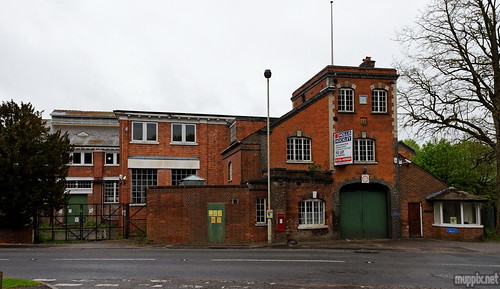
02: ... and from the inside
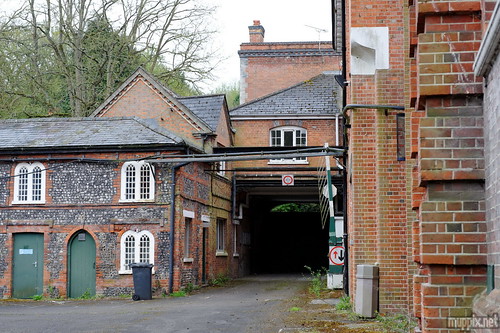
03: Top (oval) plaque reads: This house and mill was built by Henry Portal in the Year 1719. Bottom (rectangular) plaque reads: Rebuilt by Wyndham S Portal 1881.
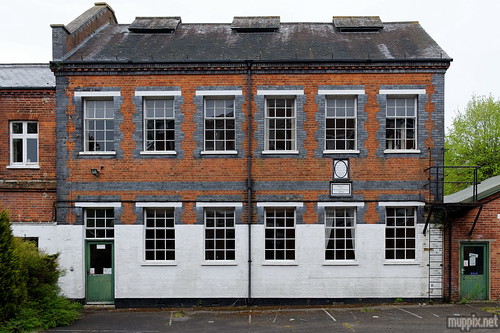
04: Number above door is 1916.
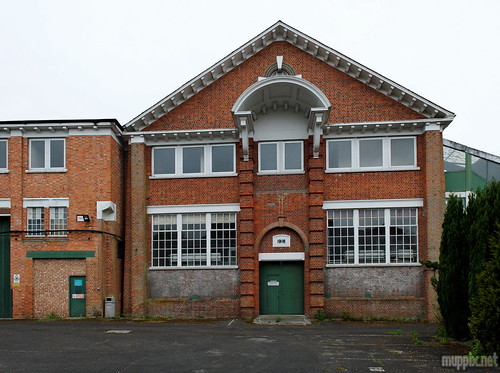
05: There are many fire escapes and other staircases to be found
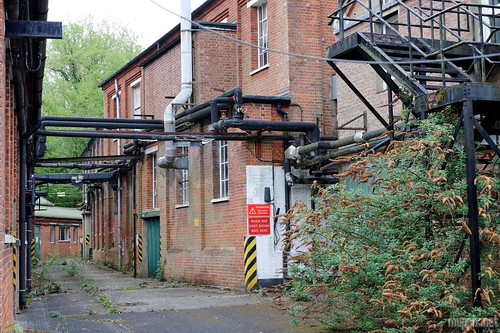
06: This would make a really pretty little courtyard.
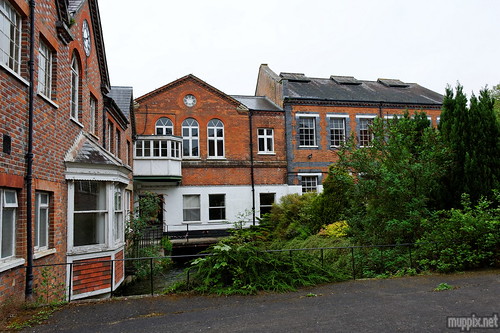
07: The ad-hoc addition of buildings probably caused a few traffic jams during busier times!
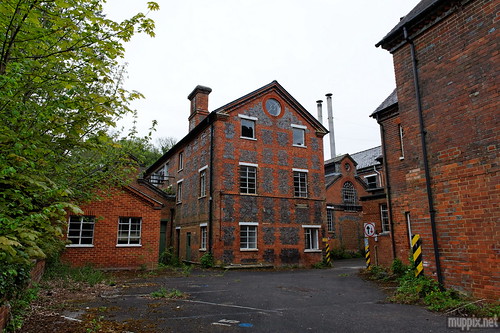
08: One of the many places where the river Test flows under the buildings.
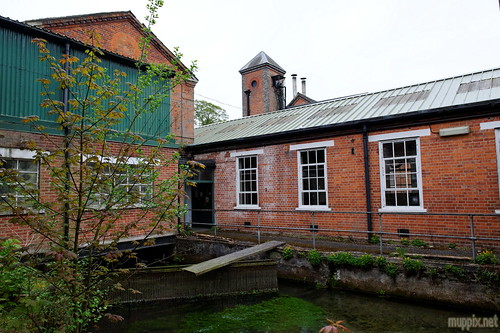
09: Bridge leading to rear car park
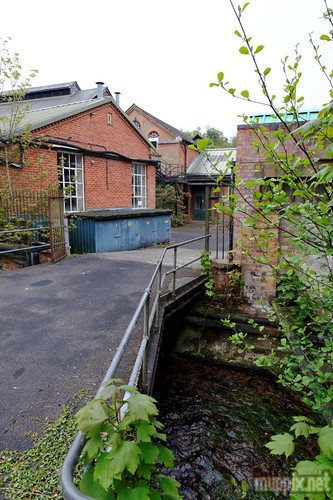
10: The buildings have been added to and extended over the years, so there's lots of little alleyways everywhere.
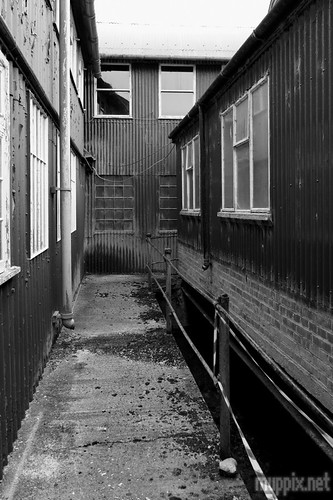
11:
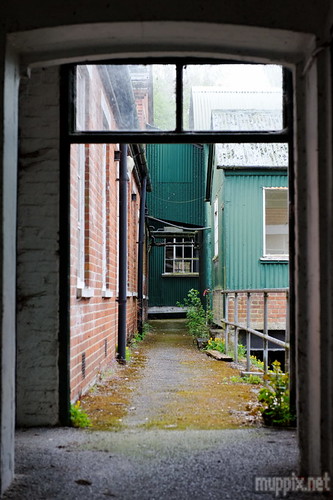
12:
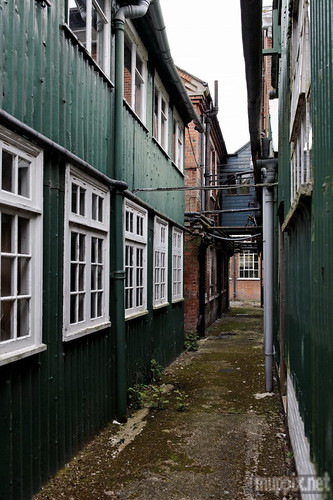
13:
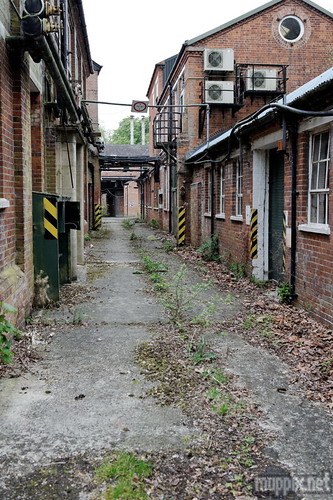
14: Traffic lights take over where the 'road' is too narrow for vehicles to pass each other

15: From one of the fire escapes.
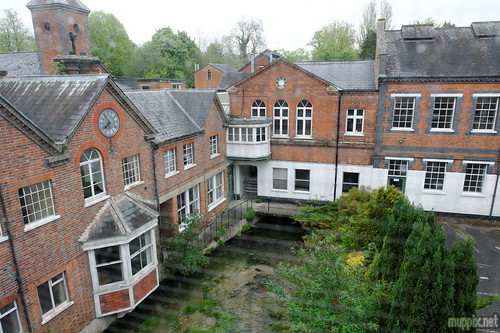
16:
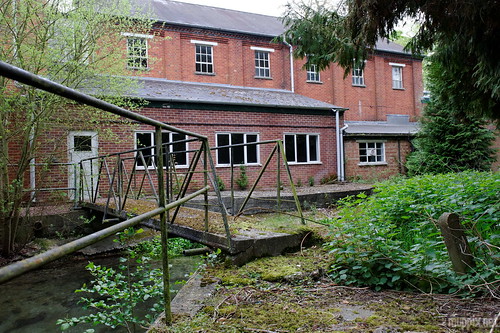
17:
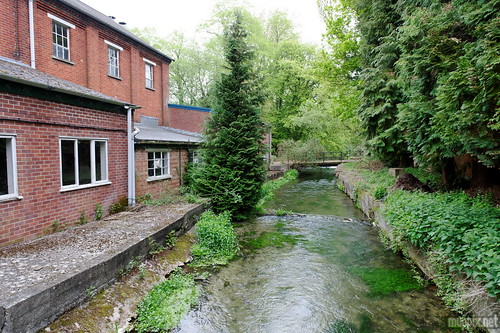
18: Residential property adjacent to the mill, also looks derelict. I wonder if this is the Freefolk Pryors mentioned as Henri de Portal's residence?
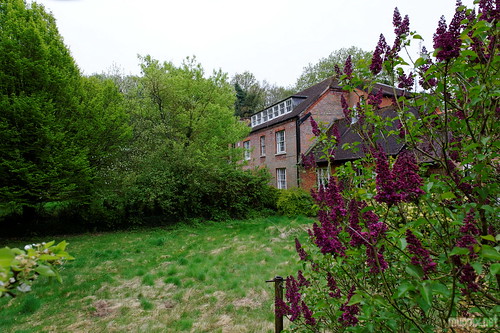
19:
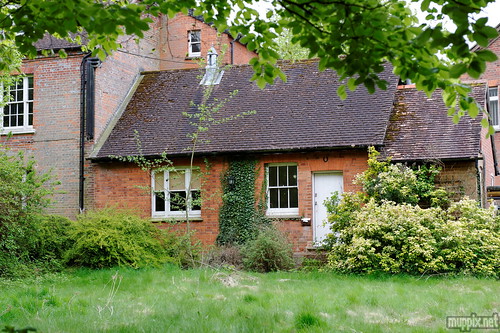
20:
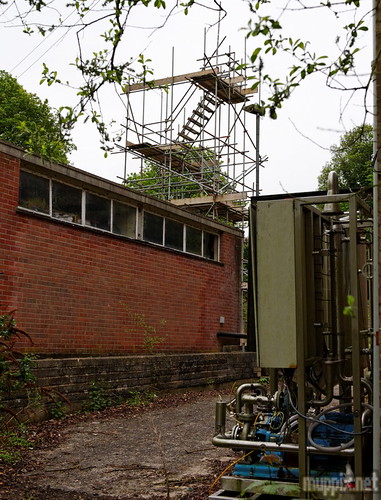
21:
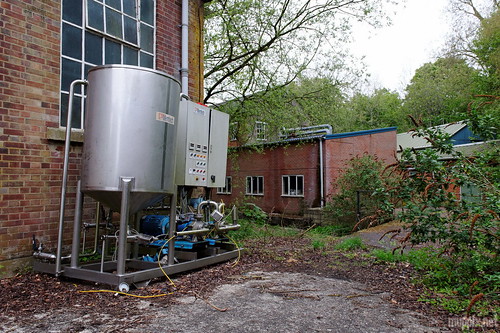
22:
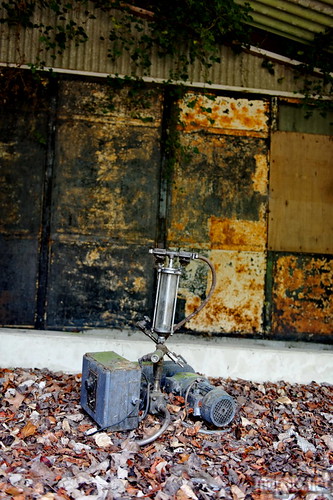
23:
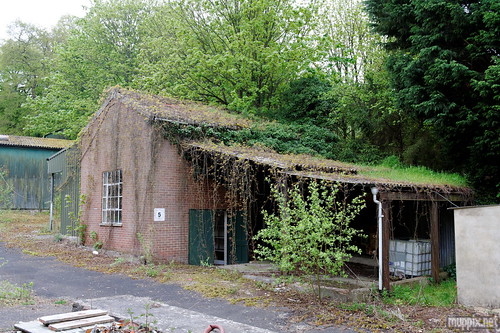
24: I'd love to learn the reason for this scaffold!
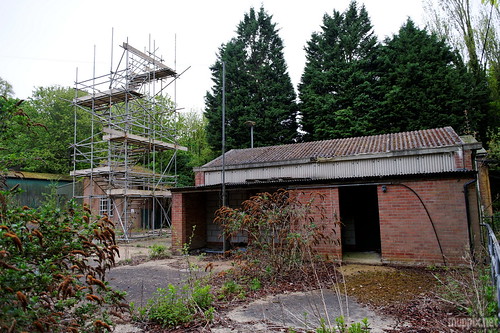
25:
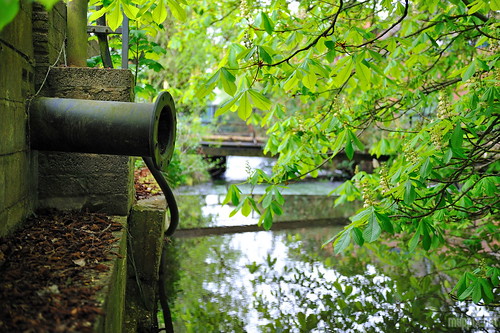
26:
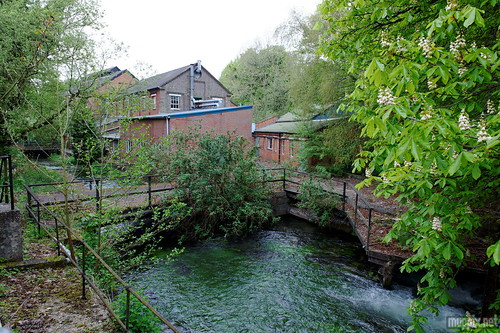
27: One of the few accessible buildings now; fire alarms seem to have been elegantly disabled.
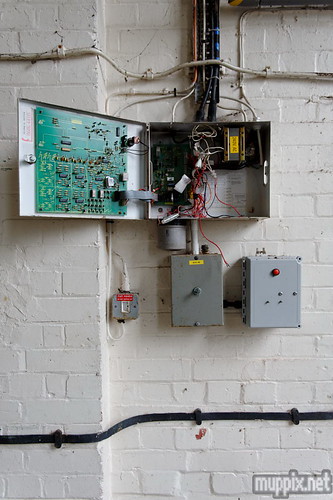
28:
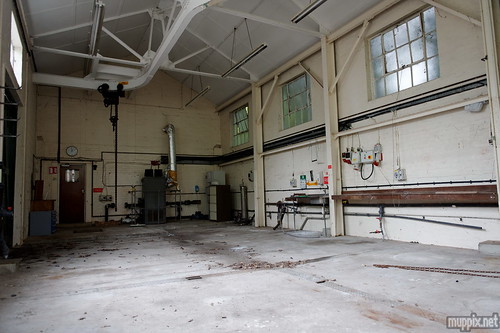
29: No idea what happened in this room, but I'm glad I wasn't in there at the time! Shot through window on fire escape.
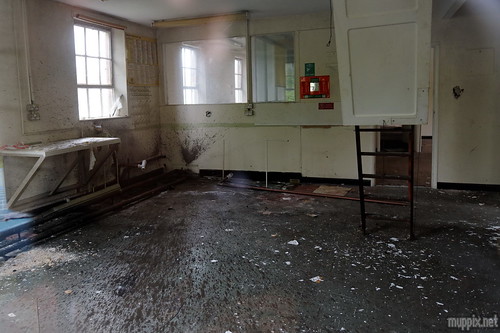
30:
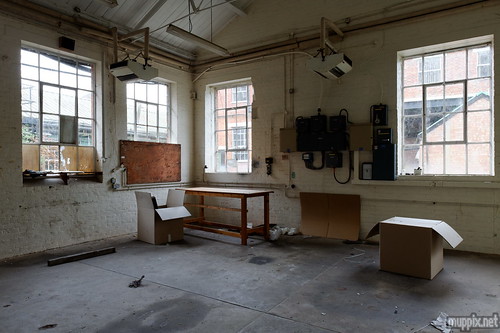
31:
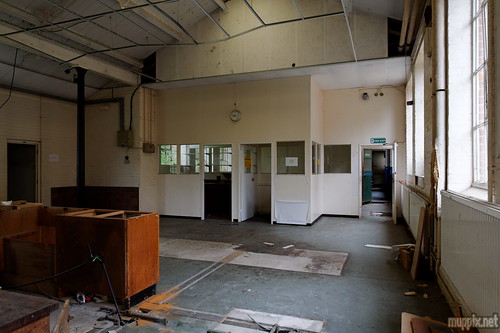
32: Toilet and shower room, fully functional.
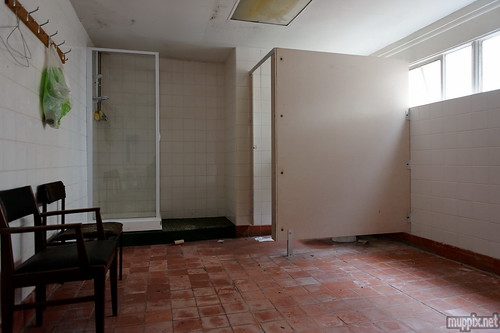
33: One that didn't get away.
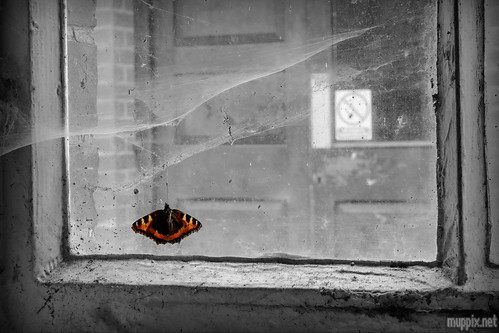
34: Bet you thought you were going to get through this without the obligatory overcooked HDR efforts. Wrong!
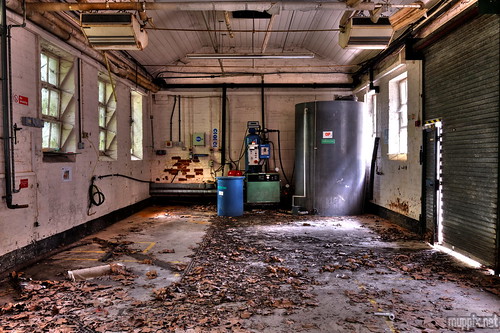
35:
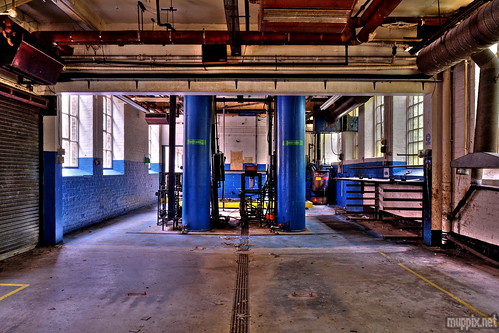
36:
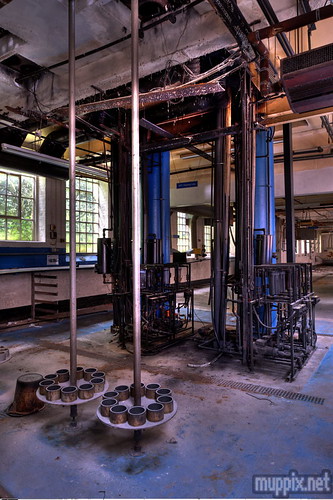
37: Pin-ups of the Suzuki B-King? Clearly the guys who worked here had great taste - I wonder if they were still around when Suzuki realeased the highly watered-down version of this supercharged 1400cc prototype. (I'll forgive the Harley pin-up, but only because the V-Rod's engine was designed by Porsche)
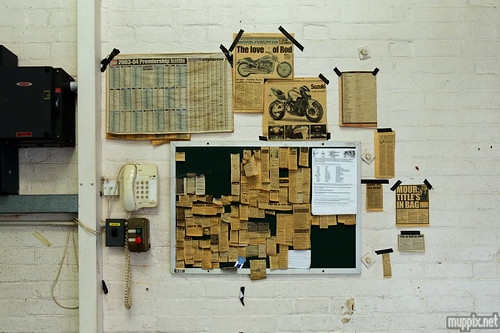
38: The next few images are upstairs from my ghastly HDR shots, and are truly as the camera 'saw' them. I'd hate to think what's going on in the respiratory systems of anyone who used to work here, although, to be fair, there was still one mask remaining in the PPE cupboard.
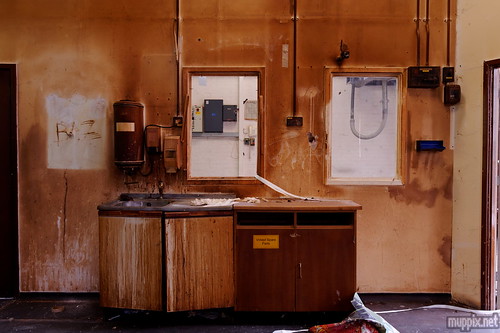
39: No, not HDR, it really looked like this.
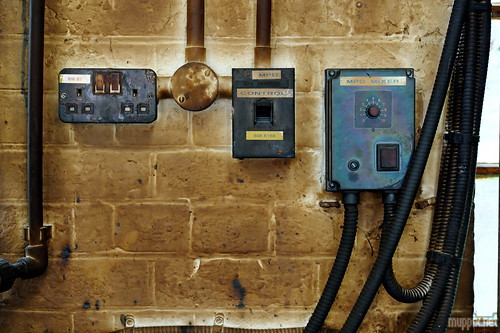
40: The first aiders are identified as K Perrett and P Longmate. Bet they were busy.
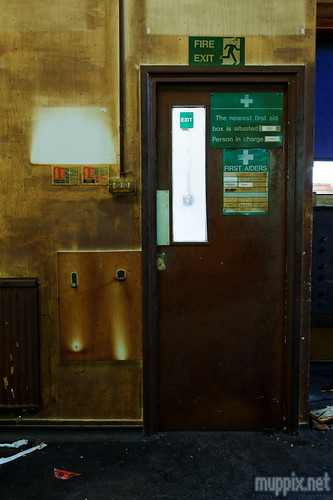
41: The sign warns of 'Danger: Hole in Floor' but we're used to that by now, right?
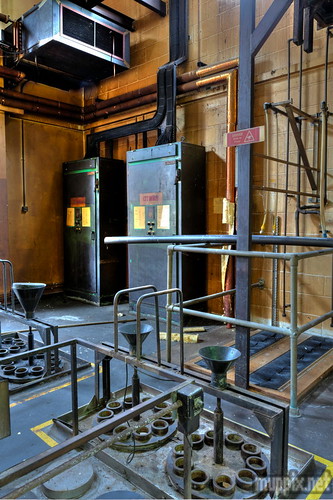
42:

43: You really didn't want to touch anything in there. Evidence to suggest the build-up of miscellaneous substances on all available surfaces was ongoing presented itself in the shape of a little smiley face, etced into the scum covering the base of the desk fan by a bored employee.
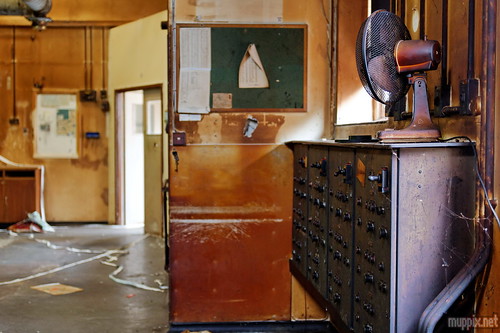
44: Spare keys right where you need 'em.
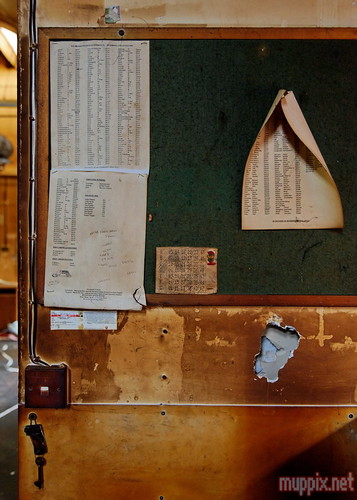
45:
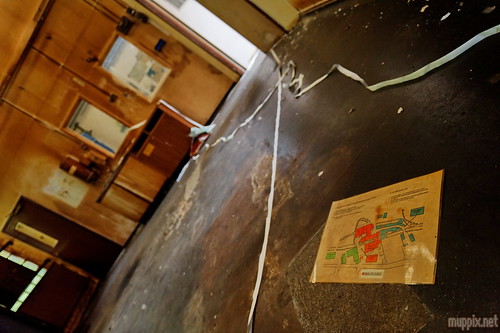
46: The sticker on the stricken telephone handset reads 'TURBO'
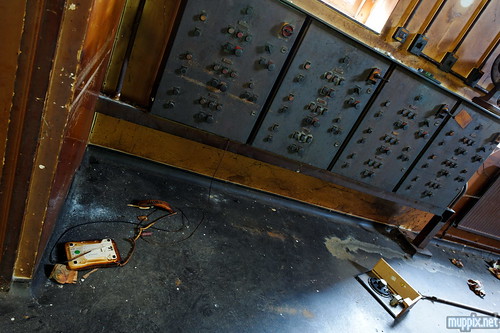
47: This reminds me of an episode of Batman, when it was still a 20 minute show full of Zap and Poww.
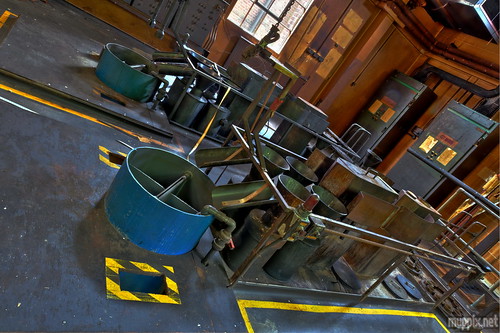
48: This you need to see in full screen to appreciate properly, see link at the bottom of the page. As if to prove that pigeons are the dumbest creatures on earth, one has made her nest on the extractor outlet near the left of the frame.
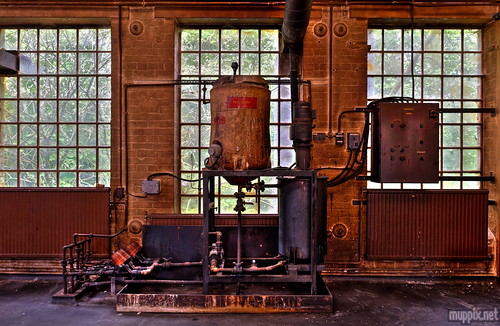
49: View from the rear car park
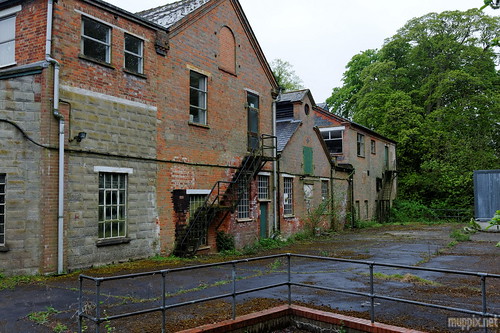
50:
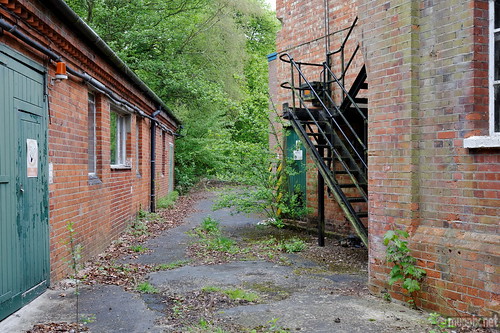
51:
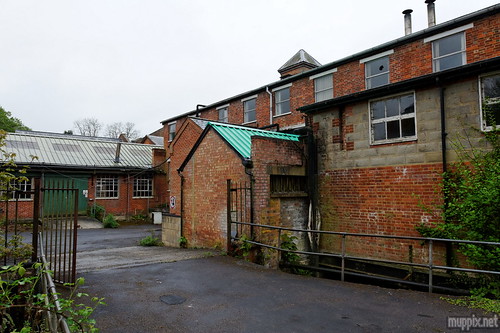
52: And finally: Krela, this one's for you.
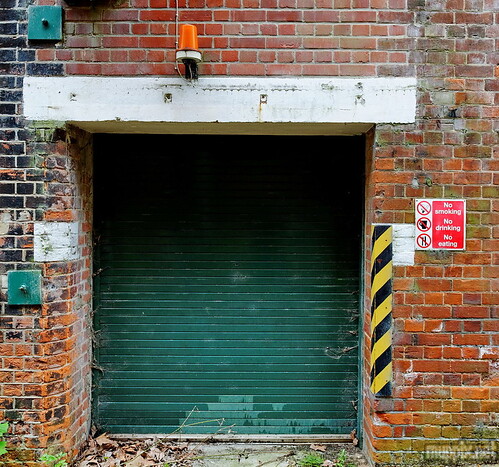
I've kept the image sizes quite small so that the page loads reasonably quickly, but if you're keen to see 'em in their full-screen glory then get yourself over to my Laverstoke gallery, where bandwidth considerations are thrown gleefully to the wind.
As always, thanks for looking!
Henri De Portal
From the days when the young son of Charles the Simple was smuggled out of Laon, hidden in a truss of straw, and brought to Athelstan's Court at Winchester, Hampshire has given refuge to many a fugitive from France. The founder of the Laverstoke paper mill was one of these. He was a descendant of a Castilian noble in the train of Elvira, daughter of Alphonso IV, on her coming to France at the close of the eleventh century, who became the ancestor of a powerful family in Languedoc and Dauphine. The de Portals for over two centuries were Capitols of Toulouse, but when the Reformation of the Christian faith, like its inception, brought "not peace but a sword", they were among the first of the French noblesse who suffered for their convictions.
A century completed their overthrow, for Louis XIV broke the Charter which protected what little liberties they might enjoy. There-with the Huguenot de Portals lost lands and lives, but three of the family escaped from torture and death to find eventual refuge in England. Of Jean Francois de Portal's escape and after adventures there is no record beyond that he died in London years later, but the tale has been handed down how, when ruin came on the Chateau de la Portalerie, an old nurse concealed the children in an oven, and when this homely refuge had baffled the searching of the angry soldiery, young Henri de Portal and his brother, Guillaume, were hidden in wine casks and were safely smuggled by faithful friends and servitors on board a lugger. Their perilous journey ended safely, and it is believed the friendly port at which they landed was Southampton. Friendly, that is, for refugees who counted freedom of faith a dearer possession than lands and country, for there was little friendly feeling towards France in the seaport her navy had so often attacked.
The Paper Mill
To Southampton, at any rate, young Henri eventually came, and there found already established the Huguenot colony that centered round the French church of St. Julian. With the aid of his fellow emigrants the lad obtained employment in one of the mills at South Stoneham, run by those of his tonfrires who were skilled in the manufacture of paper. There he learnt his trade and, more important still for the fortunes of himself and his family, met Sir William Heathcote, then, like himself, a young man. Report tells how the charm of the clever young Huguenot won him the friendship of his influential neighbour; at any rate, we find the Squire of Hursley actively forwarding the Frenchman's fortunes, and when the tenant of Bere Mill, near Whitchurch, died in 1710 Sir William offered the lease to his friend, the widowed Madame Deane being very thankful to be quit of it.
To Bere Mill accordingly came de Portal with a contingent of French workmen. Later it was to this quaint old mill-house of yellow-washed brick Henry Portal brought his bride Dorothy, the daughter of Mr. Henry Hasker of Overton.
The paper mill proved a successful venture, and commercial papers of all kinds were supplied from it so largely that in 1718 a lease was taken of the neighbouring mill of Laverstoke, in order to extend the business. In 1727 Henry Portal obtained the privilege of making the notes of the Bank of England, in addition to his other work. It was doubtless a fortunate circumstance for him that at this juncture Sir Gilbert Heathcote, the uncle of his friend at Hursley, was Governor of the Bank of England. So greatly did the business prosper that Henry Portal built another mill at Laverstoke. Thus for nearly 200 years the business has been handed down from father to son, an almost unique instance in the history of English manufactures.
Henri de Portal was naturalised at the Court of Quarter Sessions in 1711; being described in the document as "Henry Portall, of South Stoneham, gentleman."
From the days when the young son of Charles the Simple was smuggled out of Laon, hidden in a truss of straw, and brought to Athelstan's Court at Winchester, Hampshire has given refuge to many a fugitive from France. The founder of the Laverstoke paper mill was one of these. He was a descendant of a Castilian noble in the train of Elvira, daughter of Alphonso IV, on her coming to France at the close of the eleventh century, who became the ancestor of a powerful family in Languedoc and Dauphine. The de Portals for over two centuries were Capitols of Toulouse, but when the Reformation of the Christian faith, like its inception, brought "not peace but a sword", they were among the first of the French noblesse who suffered for their convictions.
A century completed their overthrow, for Louis XIV broke the Charter which protected what little liberties they might enjoy. There-with the Huguenot de Portals lost lands and lives, but three of the family escaped from torture and death to find eventual refuge in England. Of Jean Francois de Portal's escape and after adventures there is no record beyond that he died in London years later, but the tale has been handed down how, when ruin came on the Chateau de la Portalerie, an old nurse concealed the children in an oven, and when this homely refuge had baffled the searching of the angry soldiery, young Henri de Portal and his brother, Guillaume, were hidden in wine casks and were safely smuggled by faithful friends and servitors on board a lugger. Their perilous journey ended safely, and it is believed the friendly port at which they landed was Southampton. Friendly, that is, for refugees who counted freedom of faith a dearer possession than lands and country, for there was little friendly feeling towards France in the seaport her navy had so often attacked.
The Paper Mill
To Southampton, at any rate, young Henri eventually came, and there found already established the Huguenot colony that centered round the French church of St. Julian. With the aid of his fellow emigrants the lad obtained employment in one of the mills at South Stoneham, run by those of his tonfrires who were skilled in the manufacture of paper. There he learnt his trade and, more important still for the fortunes of himself and his family, met Sir William Heathcote, then, like himself, a young man. Report tells how the charm of the clever young Huguenot won him the friendship of his influential neighbour; at any rate, we find the Squire of Hursley actively forwarding the Frenchman's fortunes, and when the tenant of Bere Mill, near Whitchurch, died in 1710 Sir William offered the lease to his friend, the widowed Madame Deane being very thankful to be quit of it.
To Bere Mill accordingly came de Portal with a contingent of French workmen. Later it was to this quaint old mill-house of yellow-washed brick Henry Portal brought his bride Dorothy, the daughter of Mr. Henry Hasker of Overton.
The paper mill proved a successful venture, and commercial papers of all kinds were supplied from it so largely that in 1718 a lease was taken of the neighbouring mill of Laverstoke, in order to extend the business. In 1727 Henry Portal obtained the privilege of making the notes of the Bank of England, in addition to his other work. It was doubtless a fortunate circumstance for him that at this juncture Sir Gilbert Heathcote, the uncle of his friend at Hursley, was Governor of the Bank of England. So greatly did the business prosper that Henry Portal built another mill at Laverstoke. Thus for nearly 200 years the business has been handed down from father to son, an almost unique instance in the history of English manufactures.
Henri de Portal was naturalised at the Court of Quarter Sessions in 1711; being described in the document as "Henry Portall, of South Stoneham, gentleman."
Highways and Byways in Hampshire, 1908
Of Laverstoke Mill and Banknote Manufacture
The paper used has always been chosen so as to give a distinct look and feel. It is 80 to 90 gsm paper manufactured from cotton fibre sometimes mixed with linen and is impregnated with polyvinyl alcohol or gelatin to give it extra strength. One of the first papermakers was the firm started by a Huguenot, Henri de Portal, in 1712 at Bere Mill and in 1718 at Laverstoke Mill both on the river Test near Overton in Hampshire and carried on by his son Joseph Portal who bought Laverstoke Manor. They produced paper for Bank of England notes from 1724. They also invented the metallic thread incorporated into the paper which started off within the paper and latterly is allowed to come to the surface as a dotted line called 'windowed thread'.
A Short History of English Banknotes, B S Sharples 17 June 2009
Henri Portal's contract were of plain paper, without watermarking. Those from the Laverstoke mill had a watermark border of a loop pattern running around the edges of the sheets, and ever since 1725 the Bank of England notes have been watermarked. Henri Portal died at Freefolk Pryors, adjoining Laverstoke Mill, in 1747. He was successed by his son, Joseph Portal, who operated the mill until his death in 1793. His son John Portal, continued the fabrication of the Bank of England notes for a period of fifty three years, until his death in 1848. The paper mill is still continued by the Portals - a record of over two hundred years in the same family.
Page 294, Papermaking: the history and technique of an ancient craft by Dard Hunter

Banknote manufacture at Portals, Laverstoke Mill, Hampshire from the Illustrated London News, December 30, 1854. A curious, and perhaps unique, combination of making paper by hand and machine: couching the hand-formed sheet onto a travelling felt, which is then passed through a press section and dried using a steam-heated drying cylinder.
British Association of Paper Historians, May 07 2009
Laverstoke Mill - Recent History
Developer hopes New Plan for Mill will win Approval
Plans for a major housing development at the historic Laverstoke Mill have been re-submitted. Developer St James Group has applied to Basingstoke and Deane Borough Council to develop 72 dwellings at the mill in London Road, Laverstoke. There will be 52 homes formed from converting the mill buildings and 20 will be new-build. A heritage room and associated facilities for community use are also included in the plans.
The revised application involves work to repair and restore three Grade II listed buildings, demolish at least 25 others and restore 17 more at the 1.97 hectare site. The buildings to be demolished are newer and will make space for car parking and open space. The site is next to Laverstoke village, in a conservation area, and applications for listed building consent and conservation area consent have also been submitted. The mill buildings were constructed by the Portal family for the production of bank notes in 1724 and were used for related purposes until 1963. A company that developed and manufactured water treatment systems later occupied the land before vacating in 2005. Since then the site has remained vacant.
In October 2008, a planning application for 78 dwellings was submitted to the council, which attracted nine letters of objection, but it was withdrawn in November 2009. The revised scheme has been produced to address concerns about the design and layout of the new buildings. It reduces the number of new-build homes from 26 to 20, revises an access point, relocates parking to improve the Mill House setting and re-routes the heritage trail along the river to give a better view of the historic buildings backing on to the river. The new buildings will be simplified to be more in keeping with the industrial character of the site. Since the new plans were submitted one person has objected.
In a statement, St James Homes said that it had entered negotiations with the council because of the complex nature of the site and, as a result, reduced the number of dwellings proposed to 72. The statement added: “The changes made to the new scheme are a redesign of the new build elements in the eastern and western courtyard of the scheme to reflect the existing industrial nature of the site.”
Plans for a major housing development at the historic Laverstoke Mill have been re-submitted. Developer St James Group has applied to Basingstoke and Deane Borough Council to develop 72 dwellings at the mill in London Road, Laverstoke. There will be 52 homes formed from converting the mill buildings and 20 will be new-build. A heritage room and associated facilities for community use are also included in the plans.
The revised application involves work to repair and restore three Grade II listed buildings, demolish at least 25 others and restore 17 more at the 1.97 hectare site. The buildings to be demolished are newer and will make space for car parking and open space. The site is next to Laverstoke village, in a conservation area, and applications for listed building consent and conservation area consent have also been submitted. The mill buildings were constructed by the Portal family for the production of bank notes in 1724 and were used for related purposes until 1963. A company that developed and manufactured water treatment systems later occupied the land before vacating in 2005. Since then the site has remained vacant.
In October 2008, a planning application for 78 dwellings was submitted to the council, which attracted nine letters of objection, but it was withdrawn in November 2009. The revised scheme has been produced to address concerns about the design and layout of the new buildings. It reduces the number of new-build homes from 26 to 20, revises an access point, relocates parking to improve the Mill House setting and re-routes the heritage trail along the river to give a better view of the historic buildings backing on to the river. The new buildings will be simplified to be more in keeping with the industrial character of the site. Since the new plans were submitted one person has objected.
In a statement, St James Homes said that it had entered negotiations with the council because of the complex nature of the site and, as a result, reduced the number of dwellings proposed to 72. The statement added: “The changes made to the new scheme are a redesign of the new build elements in the eastern and western courtyard of the scheme to reflect the existing industrial nature of the site.”
The Basingstoke Gazette, Sunday 3rd January 2010
Other Business
Laverstoke Mill is in excellent condition given that the last sign of business activity appears to be around 2003 / 2004. Paperwork in the only accessible building bears the company name PCI Membranes, and research tells us:
PCI Membranes is the specialist filtration and separation company. Launched in 1967; PCI Membranes has developed expertise using all of the leading tubular, polymeric crossflow membranes and membrane configurations available on the world market and is therefore ideally placed to match a membrane to a specific application.
ITT Industries, Inc. (White Plains, NY; www.itt.com) has purchased the assets of PCI Membranes from Thames Water (Berkshire, U.K.; www.thames-water.com). The acquisition will expand the capabilities of ITT's Sanitaire Div. (Milwaukee, WI) in filtration and disinfection. PCI adds chlorination disinfection technology to the group through its Portacel div. in Winchester, U.K. In addition, PCI's membrane technology will be leveraged within Sanitaire to develop both membrane bioreactor and secondary-effluent filtration products.
www.allbusiness.com, Sat Feb 1 2003
There is sadly no trace of what must have been an impressive array of equipment in use during the paper manufacturing process (steam heated drying cylinder!) just some fairly nasty looking chemical processing equipment which has turned everything in the room the same colour as Dot Cotton's lungs. The site is remarkable for it's total absence of graffiti or other vandalism despite a sizeable dormant period. I enjoyed very much walking around the irregularly placed buildings during this solo explore and will be sorry to see the day when such an important part of English fiscal history succumbs to the bulldozers.
I think I've held your attention long enough now - for anyone who's still awake there's always a 100 page flood risk assessment you can peruse at your leisure into the small hours. There's Environment Agency emails, site plans, even details of sewers and projected precipitation levels!
I know, on with the pics...
00: Let's start with the aerial photo I got from the 'chopper on the way in ...

01: Main gate seen from outside ...

02: ... and from the inside

03: Top (oval) plaque reads: This house and mill was built by Henry Portal in the Year 1719. Bottom (rectangular) plaque reads: Rebuilt by Wyndham S Portal 1881.

04: Number above door is 1916.

05: There are many fire escapes and other staircases to be found

06: This would make a really pretty little courtyard.

07: The ad-hoc addition of buildings probably caused a few traffic jams during busier times!

08: One of the many places where the river Test flows under the buildings.

09: Bridge leading to rear car park

10: The buildings have been added to and extended over the years, so there's lots of little alleyways everywhere.

11:

12:

13:

14: Traffic lights take over where the 'road' is too narrow for vehicles to pass each other

15: From one of the fire escapes.

16:

17:

18: Residential property adjacent to the mill, also looks derelict. I wonder if this is the Freefolk Pryors mentioned as Henri de Portal's residence?

19:

20:

21:

22:

23:

24: I'd love to learn the reason for this scaffold!

25:

26:

27: One of the few accessible buildings now; fire alarms seem to have been elegantly disabled.

28:

29: No idea what happened in this room, but I'm glad I wasn't in there at the time! Shot through window on fire escape.

30:

31:

32: Toilet and shower room, fully functional.

33: One that didn't get away.

34: Bet you thought you were going to get through this without the obligatory overcooked HDR efforts. Wrong!

35:

36:

37: Pin-ups of the Suzuki B-King? Clearly the guys who worked here had great taste - I wonder if they were still around when Suzuki realeased the highly watered-down version of this supercharged 1400cc prototype. (I'll forgive the Harley pin-up, but only because the V-Rod's engine was designed by Porsche)

38: The next few images are upstairs from my ghastly HDR shots, and are truly as the camera 'saw' them. I'd hate to think what's going on in the respiratory systems of anyone who used to work here, although, to be fair, there was still one mask remaining in the PPE cupboard.

39: No, not HDR, it really looked like this.

40: The first aiders are identified as K Perrett and P Longmate. Bet they were busy.

41: The sign warns of 'Danger: Hole in Floor' but we're used to that by now, right?

42:

43: You really didn't want to touch anything in there. Evidence to suggest the build-up of miscellaneous substances on all available surfaces was ongoing presented itself in the shape of a little smiley face, etced into the scum covering the base of the desk fan by a bored employee.

44: Spare keys right where you need 'em.

45:

46: The sticker on the stricken telephone handset reads 'TURBO'

47: This reminds me of an episode of Batman, when it was still a 20 minute show full of Zap and Poww.

48: This you need to see in full screen to appreciate properly, see link at the bottom of the page. As if to prove that pigeons are the dumbest creatures on earth, one has made her nest on the extractor outlet near the left of the frame.

49: View from the rear car park

50:

51:

52: And finally: Krela, this one's for you.

I've kept the image sizes quite small so that the page loads reasonably quickly, but if you're keen to see 'em in their full-screen glory then get yourself over to my Laverstoke gallery, where bandwidth considerations are thrown gleefully to the wind.
As always, thanks for looking!



